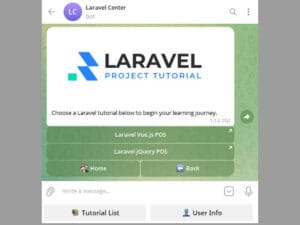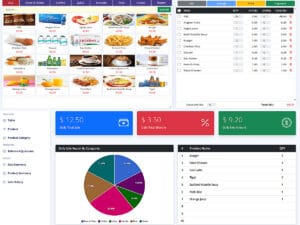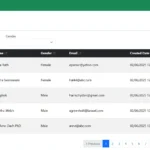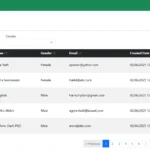In this guide, you’ll learn how to implement laravel 12 vue 3 token based authentication step by step using Laravel Sanctum. We’ll build a complete Single Page Application (SPA) that includes secure user registration, login, logout, and route protection — all connected through API tokens between Laravel 12 and Vue 3.
To make the UI look better, we’ll use Bootstrap for styling, create a simple navigation menu, and highlight the active menu when switching pages — so you can clearly see how SPA routing works.
You’ll also learn how to create a fallback route to handle pages that are not found (404) and redirect users back to the correct route.
By the end of this tutorial, you’ll have a working laravel 12 vue 3 token based authentication system with a clean Bootstrap interface, dynamic routing, and secure API communication between the frontend and backend.
What You’ll Build
You’ll create:
✅ A Laravel 12 API backend with Sanctum
✅ A Vue 3 SPA frontend using Vue Router and Pinia
✅ A secure token-based authentication system with Sanctum tokens
✅ A Bootstrap-based UI with a navigation menu
By the end, you’ll be able to:
- Register new users
- Log in and receive authentication tokens
- Access protected API routes securely
- Stay logged in using local storage
- Log out safely
- Navigate between pages with active menu highlighting
This guide is perfect for beginners who want a clear, hands-on approach to implementing token-based authentication in Laravel 12 and Vue 3 SPA.
Table of Contents
Step 1 : Create Laravel 12 Project and Configure Database
Start by creating a new Laravel 12 project using Composer and setting up your database connection in the .env file. This is the foundation for building laravel 12 vue 3 token based authentication later.
Run the following command in your terminal:
laravel new laravel-vue-token-authEdit your .env file:
DB_CONNECTION=mysql
DB_HOST=127.0.0.1
DB_PORT=3306
DB_DATABASE=laravel_vue_token_auth
DB_USERNAME=root
DB_PASSWORD=Then run the migrations:
php artisan migrateStep 2 : Install and Configure Laravel Sanctum
Install Laravel Sanctum to handle secure token generation for API authentication. Configure Sanctum’s middleware and publish its config file to enable token-based access for your SPA.
Install it via Artisan command:
php artisan install:apiOpen app/Models/User.php and ensure it uses the HasApiTokens trait:
use Laravel\Sanctum\HasApiTokens;
class User extends Authenticatable
{
use HasFactory, Notifiable, HasApiTokens;
}Step 3 : Build Authentication Controller and Routes
Run the following command in your terminal:
php artisan make:controller Api/AuthControllerThen edit app/Http/Controllers/Api/AuthController.php:
<?php
// Laravel 12 Vue 3 Token Based Authentication - http://laravelcenter.com
namespace App\Http\Controllers\Api;
use App\Http\Controllers\Controller;
use App\Models\User;
use Illuminate\Http\Request;
use Illuminate\Support\Facades\Hash;
use Illuminate\Support\Facades\Validator;
class AuthController extends Controller
{
// Register
public function register(Request $request)
{
$rules = [
'name' => 'required|string|max:255',
'email' => 'required|email|unique:users',
'password' => 'required|confirmed',
];
$validator = Validator::make($request->all(), $rules);
if ($validator->fails())
return response()->json([
'success' => false,
'errors' => $validator->errors()
]);
User::create([
'name' => $request->name,
'email' => $request->email,
'password' => Hash::make($request->password),
]);
return response()->json(['success' => true]);
}
// Login
public function login(Request $request)
{
$rules = [
'email' => 'required|email',
'password' => 'required',
];
$validator = Validator::make($request->all(), $rules);
if ($validator->fails())
return response()->json([
'success' => false,
'errors' => $validator->errors()
]);
$user = User::where('email', $request->email)->first();
if (!$user || !Hash::check($request->password, $user->password)) {
return response()->json(
[
'success' => false,
'errors' => [
'email' => ['Incorrect email or password']
]
]
);
}
$token = $user->createToken('auth_token')->plainTextToken;
return response()->json([
'success' => true,
'token' => $token,
'user' => $user->only('id', 'name', 'email'),
]);
}
// Get Authenticated User
public function user(Request $request)
{
return response()->json($request->user()->only('id', 'name', 'email'));
}
// Logout
public function logout(Request $request)
{
$request->user()->tokens()->delete();
return response()->json(['message' => 'Logged out successfully']);
}
}Open routes/web.php and add:
<?php
// Laravel 12 Vue 3 Token Based Authentication - http://laravelcenter.com
use Illuminate\Support\Facades\Route;
Route::get('{any}', function () {
return view('welcome');
})->where('any', '.*');Open routes/api.php and add:
<?php
// Laravel 12 Vue 3 Token Based Authentication - http://laravelcenter.com
use Illuminate\Support\Facades\Route;
use App\Http\Controllers\Api\AuthController;
Route::post('/register', [AuthController::class, 'register']);
Route::post('/login', [AuthController::class, 'login']);
Route::middleware('auth:sanctum')->group(function () {
Route::get('/user', [AuthController::class, 'user']);
Route::post('/logout', [AuthController::class, 'logout']);
});Step 4 : Setup Vue 3 SPA and Configure vite.config.js
Initialize your Vue 3 SPA using Vite and configure it to communicate with your Laravel 12 API. This step forms the frontend part of the laravel 12 vue 3 token based authentication system.
Install the necessary packages:
npm install --save-dev @vitejs/plugin-vuenpm install vue@3 vue-router pinia axios bootstrapUpdate content of vite.config.js file like below
import { defineConfig } from 'vite';
import laravel from 'laravel-vite-plugin';
// import tailwindcss from '@tailwindcss/vite';
import vue from '@vitejs/plugin-vue';
export default defineConfig({
plugins: [
laravel({
input: ['resources/js/app.js'],
refresh: true,
}),
// tailwindcss(),
vue({
template: {
transformAssetUrls: {
base: null,
includeAbsolute: false,
},
},
}),
],
});Open resources/js/app.js:
import './bootstrap';
import 'bootstrap/dist/css/bootstrap.min.css';
import { createApp } from 'vue'
import { createPinia } from 'pinia'
import router from './router'
import App from './App.vue'
createApp(App)
.use(createPinia())
.use(router)
.mount('#app')Step 5 : Setup Vue Router for SPA Navigation
Create resources/js/router/index.js:
import { createRouter, createWebHistory } from 'vue-router'
import { useAuthStore } from '@/stores/auth'
const routes = [
{
path: "/login",
component: () => import("@/pages/Login.vue"),
},
{
path: "/register",
component: () => import("@/pages/Register.vue"),
},
{
path: "/",
component: () => import("@/pages/Layout.vue"),
meta: {
requiresAuth: true,
},
children: [
{
path: "/",
component: () => import("@/pages/Dashboard.vue"),
},
{
path: "/data",
component: () => import("@/pages/Data.vue")
},
{
path: "/operation",
component: () => import("@/pages/Operation.vue")
},
{
path: "/report",
component: () => import("@/pages/Report.vue")
}
],
},
{
path: "/:pathMatch(.*)*",
component: () => import("@/pages/404.vue"),
}
]
const router = createRouter({
history: createWebHistory(),
routes,
})
router.beforeEach(async (to, from, next) => {
const auth = useAuthStore()
if (auth.token && !auth.user) {
await auth.getUser();
}
if (to.meta.requiresAuth && !auth.user) {
next('/login')
} else if (auth.user && ['/login', '/register'].includes(to.path)) {
next('/');
}
else {
next()
}
})
export default routerStep 6 : Create Pinia Store (auth.js)
Use Pinia for managing authentication state. The store will handle saving tokens to localStorage, checking login status, and protecting private routes.
Create resources/js/stores/auth.js:
import { defineStore } from 'pinia'
import axios from 'axios'
import router from '@/router'
export const useAuthStore = defineStore('auth', {
state: () => ({
user: null,
token: localStorage.getItem('token') || null,
}),
actions: {
async register(form) {
return await axios.post('/api/register', form);
},
async login(form) {
const response = await axios.post('/api/login', form)
if (response.data.success) {
this.token = response.data.token
this.user = response.data.user
localStorage.setItem('token', this.token)
}
return response;
},
async getUser() {
if (!this.token) return
const response = await axios.get('/api/user', {
headers: { Authorization: `Bearer ${this.token}` },
})
this.user = response.data
},
async logout() {
await axios.post('/api/logout', {}, {
headers: { Authorization: `Bearer ${this.token}` },
})
this.token = null
this.user = null
localStorage.removeItem('token')
router.push('/login')
},
},
})Step 7 : Create Vue Components
Design the frontend UI using Bootstrap for styling. Create pages for login, registration, and some protected menus. Add a navigation menu and highlight active menu items to demonstrate how a true SPA behaves.
Create resources/js/App.vue
<template>
<router-view />
</template>Create resources/js/pages/Register.vue
<template>
<section class="vh-100">
<div class="container py-5 h-100">
<div class="row d-flex justify-content-center align-items-center h-100">
<div class="col-12 col-md-8 col-lg-6 col-xl-5">
<div class="card shadow-2-strong" style="border-radius: 1rem; background: lightsteelblue;">
<div class="card-body p-5">
<h1 class="mb-4 text-center fw-bold">Register</h1>
<form @submit.prevent="register">
<div class="form-outline mb-4">
<input type="text"
:class="['form-control form-control-lg', { 'is-invalid': errors?.name }]"
placeholder="Name" ref="autofocus" v-model="form.name" :disabled="processing" />
<span v-if="errors?.name" class="text-danger form-label" style="padding-left: 5px">
{{ errors?.name[0] }}
</span>
</div>
<div class="form-outline mb-4">
<input type="text"
:class="['form-control form-control-lg', { 'is-invalid': errors?.email }]"
placeholder="Email" v-model="form.email" :disabled="processing" />
<span v-if="errors?.email" class="text-danger form-label" style="padding-left: 5px">
{{ errors?.email[0] }}
</span>
</div>
<div class="form-outline mb-4">
<input type="password"
:class="['form-control form-control-lg', { 'is-invalid': errors?.password }]"
placeholder="Password" v-model="form.password" :disabled="processing" />
<span v-if="errors?.password" class="text-danger form-label"
style="padding-left: 5px">
{{ errors?.password[0] }}
</span>
</div>
<div class="form-outline mb-4">
<input type="password" class="form-control form-control-lg"
placeholder="Confirm Password" v-model="form.password_confirmation"
:disabled="processing" />
</div>
<div class="d-grid mb-2">
<button class="btn btn-primary btn-lg" type="submit" :disabled="processing">
<span v-show="processing" class="spinner-border spinner-border-sm" role="status"
aria-hidden="true"></span>
Register
</button>
</div>
</form>
<div class="py-3 text-center fs-5">
Already have an account? <RouterLink :to="{ path: '/login' }">Login</RouterLink>
</div>
</div>
</div>
</div>
</div>
</div>
</section>
</template>
<script setup>
import { onMounted, ref } from "vue";
import { RouterLink, useRouter } from "vue-router";
import { useAuthStore } from "@/stores/auth";
const processing = ref(false);
const form = ref({
name: null,
email: null,
password: null,
password_confirmation: null
});
const errors = ref(null);
const router = useRouter();
const autofocus = ref(null);
const register = async () => {
processing.value = true;
const auth = useAuthStore();
const response = await auth.register(form.value);
if (response.data.success) {
router.push('/login');
} else {
errors.value = response.data.errors;;
setTimeout(() => {
autofocus.value.focus();
autofocus.value.select();
}, 5);
}
processing.value = false;
}
onMounted(() => {
autofocus.value.focus();
});
</script>Create resources/js/pages/Login.vue
<template>
<section class="vh-100">
<div class="container py-5 h-100">
<div class="row d-flex justify-content-center align-items-center h-100">
<div class="col-12 col-md-8 col-lg-6 col-xl-5">
<div class="card shadow-2-strong" style="border-radius: 1rem; background: lightsteelblue;">
<div class="card-body p-5">
<h1 class="mb-4 text-center fw-bold">Sign In</h1>
<form @submit.prevent="login">
<div class="form-outline mb-4">
<input type="text"
:class="['form-control form-control-lg', { 'is-invalid': errors?.email }]"
placeholder="Email" ref="autofocus" v-model="form.email"
:disabled="processing" />
<span v-if="errors?.email" class="text-danger form-label" style="padding-left: 5px">
{{ errors?.email[0] }}
</span>
</div>
<div class="form-outline mb-4">
<input type="password"
:class="['form-control form-control-lg', { 'is-invalid': errors?.password }]"
placeholder="Password" v-model="form.password" :disabled="processing" />
<span v-if="errors?.password" class="text-danger form-label"
style="padding-left: 5px">
{{ errors?.password[0] }}
</span>
</div>
<div class="d-grid mb-2">
<button class="btn btn-primary btn-lg" type="submit" :disabled="processing">
<span v-show="processing" class="spinner-border spinner-border-sm" role="status"
aria-hidden="true"></span>
Login
</button>
</div>
</form>
<div class="py-3 text-center fs-5">
Don't have an account? <RouterLink :to="{ path: '/register' }">Register</RouterLink>
</div>
</div>
</div>
</div>
</div>
</div>
</section>
</template>
<script setup>
import { onMounted, ref } from "vue";
import { RouterLink, useRouter } from "vue-router";
import { useAuthStore } from "@/stores/auth";
const processing = ref(false);
const form = ref({
email: null,
password: null
});
const errors = ref(null);
const router = useRouter();
const autofocus = ref(null);
const login = async () => {
processing.value = true;
const auth = useAuthStore();
const response = await auth.login(form.value);
if (response.data.success) {
router.push('/');
}
else {
errors.value = response.data.errors;
setTimeout(() => {
autofocus.value.focus();
autofocus.value.select();
}, 5);
}
processing.value = false;
}
onMounted(() => {
autofocus.value.focus();
});
</script>Create resources/js/pages/Layout.vue
<template>
<div>
<header
class="text-bg-success d-flex flex-wrap align-items-center justify-content-center justify-content-md-between py-3 mb-4 border-bottom">
<div class="col-md-3 mb-2 mb-md-0 d-flex">
<a href="/" class="d-inline-flex link-body-emphasis text-decoration-none">
<strong class="fs-3 ms-2 text-white">Laravel Center</strong>
</a>
</div>
<ul class="nav nav-underline col-12 col-md-auto mb-2 justify-content-end mb-md-0">
<li class="nav-item">
<router-link :to="{ path: '/' }"
:class="['nav-link mx-2 text-white', { 'active': $route.path == '/' }]">Dashboard</router-link>
</li>
<li class="nav-item"><router-link :to="{ path: '/data' }"
:class="['nav-link mx-2 text-white', { 'active': $route.path == '/data' }]">Data</router-link>
</li>
<li class="nav-item"><router-link :to="{ path: '/operation' }"
:class="['nav-link mx-2 text-white', { 'active': $route.path == '/operation' }]">Operation</router-link>
</li>
<li class="nav-item">
<router-link :to="{ path: '/report' }"
:class="['nav-link mx-2 text-white', { 'active': $route.path == '/report' }]">Report</router-link>
</li>
</ul>
<div class="col-md-3 text-end">
Welcome, {{ auth.user?.name }}
<button type="button" class="btn btn-danger me-2" v-if="auth.user"
@click="auth.logout()">Logout</button>
</div>
</header>
<div class="container mt-5">
<router-view></router-view>
</div>
</div>
</template>
<script setup>
import { useAuthStore } from '@/stores/auth';
const auth = useAuthStore();
</script>Create resources/js/pages/Dashboard.vue
<template>
<div>
<h1 class="fw-bold">Dashboard</h1>
</div>
</template>Create resources/js/pages/Data.vue
<template>
<div>
<h1 class="fw-bold">Data</h1>
</div>
</template>Create resources/js/pages/Operation.vue
<template>
<div>
<h1 class="fw-bold">Operation</h1>
</div>
</template>Create resources/js/pages/Report.vue
<template>
<div>
<h1 class="fw-bold">Report</h1>
</div>
</template>Create resources/js/pages/404.vue
<template>
<div class="d-flex align-items-center justify-content-center vh-100" style="background: whitesmoke">
<div class="text-center">
<h1 class="fw-bold" style="font-size: 200px">404</h1>
<p class="fs-3"><span class="text-danger">Opps!</span> Page not found.</p>
<p class="lead">The page you’re looking for doesn’t exist.</p>
<router-link :to="{ path: '/' }" class="btn btn-primary pt-1">Go Home</router-link>
</div>
</div>
</template>Step 8 : Configure Blade Entry File
In resources/views/welcome.blade.php:
<!DOCTYPE html>
<html lang="{{ str_replace('_', '-', app()->getLocale()) }}">
<head>
<meta charset="utf-8">
<meta name="viewport" content="width=device-width, initial-scale=1">
<title>{{ config('app.name', 'Laravel') }}</title>
<!-- Fonts -->
<link rel="preconnect" href="https://fonts.bunny.net">
<link href="https://fonts.bunny.net/css?family=instrument-sans:400,500,600" rel="stylesheet" />
<!-- Styles / Scripts -->
@vite('resources/js/app.js')
</head>
<body>
<div id="app"></div>
</body>
</html>Step 9 : Run, Test, and Verify Authentication
Finally, run both Laravel and Vue servers, test the registration and login flow, and verify that API requests use Sanctum tokens for secure laravel 12 vue 3 token based authentication between frontend and backend.
Start servers:
npm run dev
php artisan serve
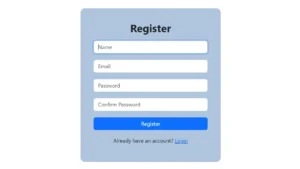


Summary
By following these steps, you’ve successfully built a complete laravel 12 vue 3 token based authentication system from scratch — including API creation, SPA setup, route protection, and a clean Bootstrap UI. This setup provides a strong foundation for developing modern, secure single-page applications with Laravel and Vue 3.
If you’d like to explore an alternative authentication approach, check out my related guide on
👉 Laravel 12 Vue 3 Session Based Authentication – Complete SPA Tutorial for Beginners
to learn how to implement secure session-based login using cookies instead of tokens.



